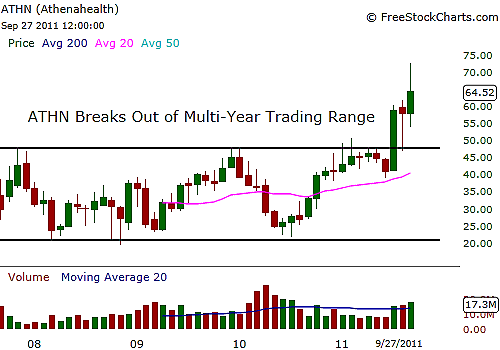
HOT TOPICS LIST
- MACD
- Fibonacci
- RSI
- Gann
- ADXR
- Stochastics
- Volume
- Triangles
- Futures
- Cycles
- Volatility
- ZIGZAG
- MESA
- Retracement
- Aroon
INDICATORS LIST
LIST OF TOPICS
PRINT THIS ARTICLE
by Billy Williams
There is an art to stock selection, and these three criteria can make the difference between selecting an average stock versus one with runaway potential.
Position: Buy
Billy Williams
Billy Williams has been trading the markets for 27 years, specializing in momentum trading with stocks and options.
PRINT THIS ARTICLE
STRATEGIES
Three Little-Known Factors For Stock Selection
09/29/11 09:47:14 AMby Billy Williams
There is an art to stock selection, and these three criteria can make the difference between selecting an average stock versus one with runaway potential.
Position: Buy
| Investors and traders alike approach the markets methodically in the hopes of achieving stellar returns by doing painstaking research on the next winning stock. Some of the more prevalent methods of selecting stocks that have the potential of becoming the next Apple Inc. look for companies with outstanding products or services that give them a distinct competitive advantage in their marketplace, picking companies that have exceptional sales growth for several consecutive years, little or no debt, and exceptional management as strong indicators of a fundamentally sound company that is likely to see its shares go higher. However, there are three other factors to consider that can help you not only find a stock that has the potential to go higher but could lead to a stock selection that could go on to make triple-digit returns. They are: the number of outstanding shares, the stock float, and the top three stocks in the selected stock's industry having a relative strength (RS) ranking of 90 or higher. See Figure 1. |

|
| FIGURE 1: ATHN. ATHN has outstanding shares of 35 million, a stock float of just over 34 million, and is the top stock in the strongest industry right now with leading stocks CERN and QSII all possessing a relative strength reading of over 90, which helped ATHN break out of a multiyear trading range. |
| Graphic provided by: www.freestockcharts.com. |
| |
| The term "outstanding shares" refers to the stock currently held by investors, including restricted shares owned by the company's officers and insiders, as well as those held by the public. You want to select a stock with outstanding shares at 200 million or less without saturating the market. The reason you want to avoid saturating the market with shares is that as demand for the shares begins to grow, it causes the stock's price to rise. As price begins to rise, demand can also begin to rise, which results in stock splits, which compound the returns of any early position you take. |
| The stock float refers to a company's shares that are freely bought and sold without restrictions to the public with the greatest proportion of these shares trading on the exchanges, which you hear being discussed on the news or written about in financial periodicals and is important because it reveals the number of available shares. For example, if you have one million outstanding shares and management owns 100,000 shares, then you have a stock float of 900,000 shares. |
| The stock float is important because as a stock is gathering attention and seeing demand grow for its shares, it attracts the large institutions and mutual funds into taking a position. Because they have such buying power, as the stock undergoes accumulation of its shares, then its price will rise as a result of demand. With greater demand for the available stock float, you can build a small position and then add to it as institutional demand for the stock causes it to rise in price. Finally, you want to look at the top three stocks within a stock candidate's industry and see if they have an RS of 90 or higher. By confirming that there is strength among the leading stocks of a sector, you increase the odds of finding a winning stock that will be supported in an upward move and not weighed down by underperforming stocks within its industry. |
| These criteria are rarely considered when picking a solid candidate for stock trading but can make the difference between a losing stock or a winning stock or even a runaway stock. However, even if you pick a solid performing stock that is set to break higher, you can still lose money by lacking the ability to pick your entry points and exit points. If you can do that, then spend the majority of your time trying to find the right vehicle to trade with these three criteria, and your success is that much closer to becoming a reality. |
Billy Williams has been trading the markets for 27 years, specializing in momentum trading with stocks and options.
| Company: | StockOptionSystem.com |
| E-mail address: | stockoptionsystem.com@gmail.com |
Traders' Resource Links | |
| StockOptionSystem.com has not added any product or service information to TRADERS' RESOURCE. | |
Click here for more information about our publications!
PRINT THIS ARTICLE

|

Request Information From Our Sponsors
- StockCharts.com, Inc.
- Candle Patterns
- Candlestick Charting Explained
- Intermarket Technical Analysis
- John Murphy on Chart Analysis
- John Murphy's Chart Pattern Recognition
- John Murphy's Market Message
- MurphyExplainsMarketAnalysis-Intermarket Analysis
- MurphyExplainsMarketAnalysis-Visual Analysis
- StockCharts.com
- Technical Analysis of the Financial Markets
- The Visual Investor
- VectorVest, Inc.
- Executive Premier Workshop
- One-Day Options Course
- OptionsPro
- Retirement Income Workshop
- Sure-Fire Trading Systems (VectorVest, Inc.)
- Trading as a Business Workshop
- VectorVest 7 EOD
- VectorVest 7 RealTime/IntraDay
- VectorVest AutoTester
- VectorVest Educational Services
- VectorVest OnLine
- VectorVest Options Analyzer
- VectorVest ProGraphics v6.0
- VectorVest ProTrader 7
- VectorVest RealTime Derby Tool
- VectorVest Simulator
- VectorVest Variator
- VectorVest Watchdog
